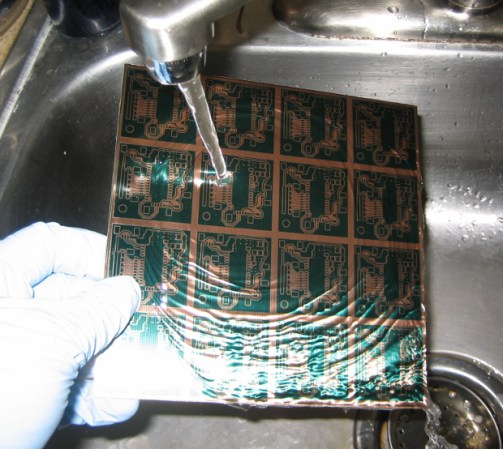
From what we’ve seen we’d say [Jianyi Liu] is really good at etching PCBs at home. Now you can learn from his experience. He just published a mammoth guide to fabricating your own PCBs at home. That link goes to his index page which leads to all eight parts of the guide.
He starts off by mentioning that fab house boards are rather inexpensive these days. This will save you a lot of trouble (like acquiring the equipment and raw materials needed to get up and running) but you can’t beat the turnaround time of doing it yourself.
After discussing the particulars about trace width, copper thickness, and a few design considerations he lays out his board and prints the artwork to a sheet of transparency film. A pre-sensitized board is cut to size before a trip through an exposure rig with the film taped onto it. The image above shows him rinsing the board after applying the developer chemical. From here he uses cupric chloride he mixed himself to etch the board. [Jianyi] recommends populating the components before cutting the panel apart — a task which he accomplishes with a hack saw.
















Yikes. The advertising spam on that site is a little over the top.
use adblock
your not using noscript ?
i saw no adds lol
I have no problem with sites that use ads for revenue (I wouldn’t do it myself, but I understand why some do) but there is a limit. I like hack-a-day, for example, and am happy that can make money showing me a *few* ads in a way that doesn’t detract from the usefulness of the site (though a few fewer might be nice). The tutorial above just goes a little (lot) past my limit.
Ah, that is why i got the impression it was rehashed but not very useful content spread out over multiple pages.
It is certainly not a guide of mammothian proportions. Lots of wool it has, though and an ancient carcass.
I’m beginning to think thatifyou want consistent diy etched boards you’ve got to move away from toner transfer to photo resist.
Toner transfer gained some popularity because pre-sensitized copper clad are stupidly pricy. Nevertheless, it’s still the best way to etch your own pcbs when you master the process.
Toner transfer is too exhaustive and too prone to failure.
Photo resist rocks, because depending on your printer, you can do really small footprints etc. (the laser printer at shackspace lets us do 1/10mm AFAIR and it’s a rather old one)
Another nice method is ink resist printing. Just need a slightly modded Inkjet photo printer with CD-Tray and a special heat-hardened ink. Print directly on copper, put it into the oven and throw it into the etchant. Done. But superprecise inkjets are expensive. Our Epson Photo R800 was almost good enough for QFN package, but you had to do everything perfect to achieve that.
I use two techniques.
If you use specific paper for toner transfer like PNP blue, it’s a great way to do. I have no failure and thickness is rather good (I can easily handle 0.5mm package). But forget about photo paper transfer it’s a pain…
UV are great when you have ALWAYS the same brand of copper… The time in the UV machine is really different between each brand and some of them are just crap with more than 3 minutes on top of 4 UV tubes… You take the risk to have blurry track and micro cut. I loved some Japanese pre-sensitized copper plate, but I can’t manage to have them now, you only needed 1 minutes of UV exposure !
Yeah, that’s the problem with photoboards, you have to use ones from the same manufacturer if you want reproductability.
Also, once you’ve established and streamlined a process, you can’t change anything.
Causes of failure range from another material to another UV-light.
photoresist schmotoresist!
Use a lasercutter/engraver to remove your etch resist directly. :)
What kind of hacker are you? I use a stanley knive to make my ccbs (carved circuit board)
I wouldn’t populate a board and then cut it apart, with a hacksaw no less. That’s asking for stress failures, you may get away it on an all through-hole board of decent thickness and plated holes, but a thinner board and surface mount, bad, bad, baaaaddddd idea. Just flexing a board a little can crack solder joints and come back to haunt you. Thats why a lot of cheaper or older boards fail, they tend to curl as they age and draw moisture, and it breaks solder joints. A reflow can fix some of them, but still… I wouldn’t do it that way unless I wanted trouble.
I Agree, populating should be done after hand cutting, except if you have the necessary CNC to drill it without physical constraint.
That’s a really good tutorial for ONE way to make a PCB at home. There are MANY ways, and all of them are documented, with tips, tricks, and ideas at
http://techref.massmind.org/techref/pcbs.htm